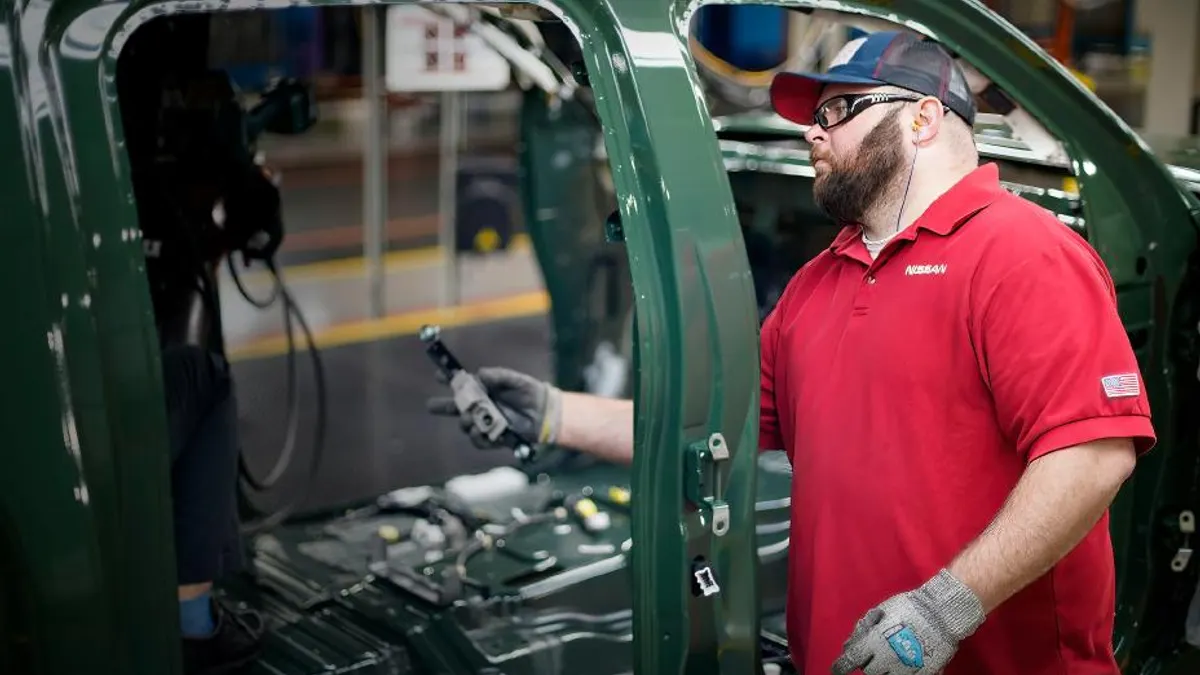Toyota first pioneered the concept of just-in-time (JIT) manufacturing in the 1970s. Since then, thousands of companies have successfully taken a page from its playbook. From Dell to Burger King and Harley Davidson, the JIT approach makes sense for a wide range of businesses.
The main philosophy behind JIT is to eliminate waste, whether stock, inventory or time. Manufacturers keep a lean supply of materials on hand and produce their products when demanded in rapid-fire fashion. It takes a widespread, end-to-end supply chain approach, which can be tricky, but worth it.
Pulling off a winning JIT strategy requires the right building blocks, said Dr. Robert Lee Gordon, program director of reverse logistics management in the American Public University System. "It requires putting the right structure and monitoring systems in place," he told Supply Chain Dive.
KPIs as building blocks for JIT
In a world where JIT is no longer a novelty, margins are thinner than ever, said Ken Ackerman, president of consultancy The Ackerman Company in Columbus, Ohio. "Delivering faster than others is still a competitive advantage," he said, "but it’s lost some of its luster."
As a result, the pressure is on to differentiate with top-notch timing and service. Picking the right key performance indicators (KPIs) to measure is critical to supporting that strategy. If a business isn't on top of indicators like the customer’s desired timing, delivery windows and communication, it can’t pull ahead of the competition.
First and foremost among the right KPIs, Ackerman told Supply Chain Dive, is timing. "What’s your lead time?" he said. "You have to be on top of the number of hours or days between taking an order and putting a finished product into the hands of customers."
"JIT is not for every company, so making sure to find the right partner is very important."

Dr. Robert Lee Gordon
Program Director of Reverse Logistics Management, American Public University System
Important to timing, said Ackerman, is knowing exactly what the customer wants in this regard. "We worked with a client who was spending big money to meet same-day production on any orders received by 4 p.m.," he said. "But the manufacturer didn’t check to see if its customers really wanted that — they didn’t. So they were giving a service that wasn’t needed, at a high cost."
Gordon emphasized the importance of monitoring missed deliveries. "Examine by how much you failed," he said. "If you have a 2% failure rate, is that made up of deliveries that were 15 minutes late? Or days late? There’s a significant cost differential in one versus the other." On the other hand, "track your wins and understand why those deliveries worked," he said.
Monitoring how well an organization responds when it doesn’t meet JIT and customer expectations is a helpful KPI, as well. Gordon recommended establishing an EDI relationship with the partner company in order to track all the data. "Monitoring the data over time can get a good feel for what is happening," he said. He suggested setting baseline requirements for in-full and on-time deliveries. "That sets the benchmarks and then one can compare to those contracted levels."
JIT in the extended supply chain
Forming the right partnerships is crucial when starting out with JIT. "Partnering with the wrong supplier can lead to downtime, slowdowns and materials sitting and waiting," said Gordon. "In the end, that can cost you more than not implementing JIT."
Vetting can actually be quite simple. "It comes down to asking a company if they are willing to do a JIT program" Gordon said. "Many are and one can always ask for references to see how they are performing with others."
There are red flags to watch for, however. "If the partner company is not fully dedicated to the program, they are not right for it," said Gordon. "Another warning sign would be if they have no experience with it — JIT is not for every company so making sure to find the right partner is very important."
He said operations managers also need backup plans. "Don’t be at the mercy of one company," he said. "Consider depending on a supplier for 80% of your materials and another for 20%, for instance. That way if something goes awry, you have a way to get materials or parts. You’re reducing the risk of a single point of failure."
When undertaking JIT, Gordon suggests beginning with known reliable suppliers, bypassing those who aren’t and then developing a contract.
In that same vein, forecasting beyond current parameters is a smart move. If a company needs to ramp up production rates, it must first determine if suppliers can keep up before implementing JIT. "Evaluate them with qualitative and quantitative data,” said Gordon. "Review how they perform to the targets, but also review how well they are communicating."
Also important to monitor is communication with customers and partners. "If you missed a delivery window, did you call ahead and let the customer know about it?" Gordon said. "Or did you show up and hope the customer didn’t notice? If the customer has time to react to a late delivery, it will make all the difference to them. You have to communicate in advance when there are issues."
JIT success stories
When pulled off, JIT can work for small and large manufacturers, as myriad examples reveal. Harley Davidson is one such example, shrinking inventory levels by 75% while simultaneously raising productivity. Inventory turns went from two a year to 17. While controversial from a union perspective, the main factory in York, Pennsylvania, also cut the workforce from about 2,700 to 1,600 during its '80s push to lean out.
Dell is another JIT success story. It stands as unique from many others in that it requires its suppliers to carry inventory. Dell demands they deliver components on short lead times, and Dell then quickly assembles the computers and ships them off to the customer.
Even fast-food king McDonald’s famously improved its customer service by implementing a version of JIT. High holding costs can lead to slow delivery and wastage in this business. McDonald’s changed its approach by adding sophisticated burger-making technology and waiting to make burgers until they are ordered, delivering a higher quality product and cutting down on waste.
"If you’re successful, you can expect improved cash flow and happier customers," Gordon said.
This story was first published in our weekly newsletter, Supply Chain Dive: Operations. Sign up here.





















